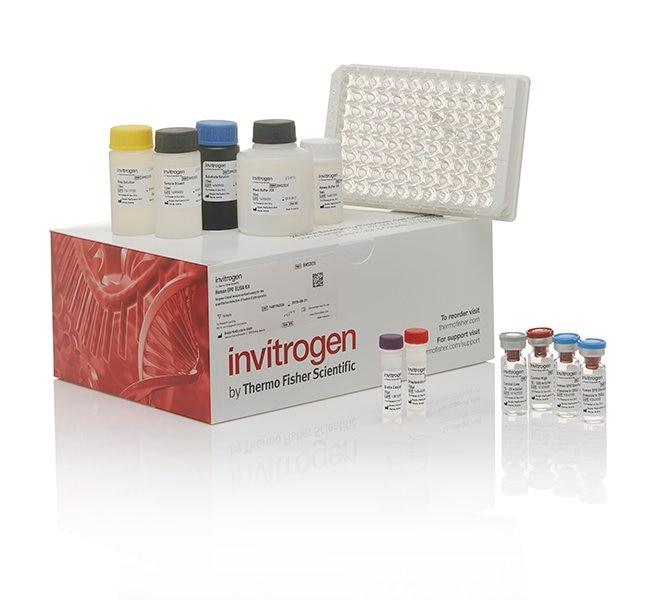Search Thermo Fisher Scientific
Product Specifications
Analytical sensitivity
Assay range
Sample type/volume
Hands-on time
Time-to-result
Homogenous (no wash)
Interassay CV
Intraassay CV
Instrument
Product size
Contents
Standard
Assay Diluent concentrate
Biotinylated Detection Antibody
SAV-HRP
Wash Buffer
Chromogen
Stop Solution
Adhesive Plate Covers
Shipping conditions
Storage
Protein name
Protein family
Species (tested)
Assay kit format
Detector antibody conjugate
Label or dye
About This Kit
The Human Ubiquitin 1 RPS27A ELISA quantitates Hu Ubiquitin in human serum, plasma, or cell culture medium. The assay will exclusively recognize both natural and recombinant Hu Ubiquitin.
Principle of the method
The Human Ubiquitin solid-phase sandwich ELISA (enzyme-linked immunosorbent assay) is designed to measure the amount of the target bound between a matched antibody pair. A target-specific antibody has been pre-coated in the wells of the supplied microplate. Samples, standards, or controls are then added into these wells and bind to the immobilized (capture) antibody. The sandwich is formed by the addition of the second (detector) antibody, a substrate solution is added that reacts with the enzyme-antibody-target complex to produce measurable signal. The intensity of this signal is directly proportional to the concentration of target present in the original specimen.
Rigorous validation
Each manufactured lot of this ELISA kit is quality tested for criteria such as sensitivity, specificity, precision, and lot-to-lot consistency. See manual for more information on validation.
Ubiquitin, a highly conserved protein that has a major role in targeting cellular proteins for degradation by the 26S proteosome, is synthesized as a precursor protein consisting of either polyubiquitin chains or a single ubiquitin fused to an unrelated protein. This gene encodes a fusion protein consisting of ubiquitin at the N terminus and ribosomal protein S27a at the C terminus. When expressed in yeast, the protein is post-translationally processed, generating free ubiquitin monomer and ribosomal protein S27a. Ribosomal protein S27a is a component of the 40S subunit of the ribosome and belongs to the S27AE family of ribosomal proteins. It contains C4-type zinc finger domains and is located in the cytoplasm. Pseudogenes derived from this gene are present in the genome. As with ribosomal protein S27a, ribosomal protein L40 is also synthesized as a fusion protein with ubiquitin; similarly, ribosomal protein S30 is synthesized as a fusion protein with the ubiquitin-like protein fubi. Multiple alternatively spliced transcript variants that encode the same proteins have been identified.
For Research Use Only. Not for use in diagnostic procedures. Not for resale without express authorization.
References (0)
Bioinformatics
Gene aliases : CEP52, CEP80, HEL-S-50, HEL112, HMG20, HUBCEP52, L40, RPL40, RPS27A, RPS27L, S27A, UBA52, UBA80, UBB, UBC, UBCEP1, UBCEP2, UBCEP80
Gene ID : (Human) 6233, (Human) 51065, (Human) 7311, (Human) 7314, (Human) 7316
Gene symbol : RPS27A, RPS27L, UBA52, UBB, UBC
Protein Aliases : 40S ribosomal protein S27-like, 40S ribosomal protein S27a, CEP52, epididymis luminal protein 112, epididymis secretory protein Li 50, polyubiquitin B, Polyubiquitin-B, Polyubiquitin-C, Ribosomal protein eS27-like, ribosomal protein S27-like, RPS27L, Small ribosomal subunit protein eS27-like, Ubiquitin A-52 residue ribosomal protein fusion product 1, ubiquitin and ribosomal protein S27a, ubiquitin C, ubiquitin carboxyl extension protein 52, Ubiquitin carboxyl extension protein 80, ubiquitin-52 amino acid fusion protein, ubiquitin-CEP52, ubiquitin-CEP80, Ubiquitin-ribosomal protein eL40 fusion protein, Ubiquitin-ribosomal protein eS31 fusion protein
UniProt ID (Human) P62979, (Human) Q71UM5, (Human) P62987, (Human) P0CG47, (Human) P0CG48

Performance Guarantee
If an Invitrogen™ antibody doesn't perform as described on our website or datasheet,we'll replace the product at no cost to you, or provide you with a credit for a future purchase.*
Learn more
We're here to help
Get expert recommendations for common problems or connect directly with an on staff expert for technical assistance related to applications, equipment and general product use.
Contact tech support

